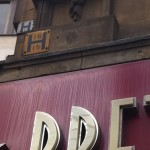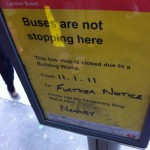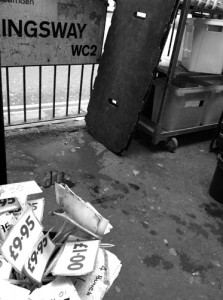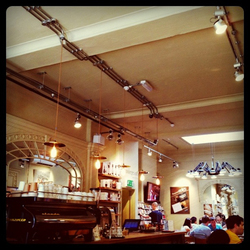A year or so ago, I was invited by the executives at the company where I worked to participate in a series of soul-searching business strategy meetings. At some point in the second or third session, I dropped a bomb. The core problem of interactive agencies, and indeed of the whole agency model, I argued, was that the work being produced was simply mediocre.
Notes on the London Urban Walkshop
June 2, 2011
Last month, I was in the happy few attending the first London installment of the “Systems/Layers Walkshop” organised by Adam and Nurri of Do Projects.
![]() Most will think “spelling mistake” when reading about the idea of a “walkshop”, and a few others will think ”oh yeah, the thing with the security cameras?” For some reason, the walkshops have been equated with some kind of performance of “the men who stare at surveillance cameras”.
Most will think “spelling mistake” when reading about the idea of a “walkshop”, and a few others will think ”oh yeah, the thing with the security cameras?” For some reason, the walkshops have been equated with some kind of performance of “the men who stare at surveillance cameras”.
And, indeed, as soon as the walkshop took off, we had around 20 people standing under a couple of the CCTV cameras around the building which was our host for the day. We talked about surveillance and the idea of the panopticon, exchanged literary references and knowledge about our surveilance society. Did you know that only 3 crimes in 1000 are solved with the aid of CCTV? [Citation Needed].
The walkshop was driven by so much more than a rabid fascination for the many CCTV cameras and the almost unavoidable (especially in London and the UK) peeping patchwork they create in their juxtaposed sights. These just happen to be a really good excuse to bring up the tricky questions. Not just “Why are there surveillance cameras?” but also “where does the video feed go?”, “to whom?”, “Who controls the camera when it pans left and right? Isn’t that automated?”, or even “How is the information transmitted, processed, stored when it leaves the camera?”.
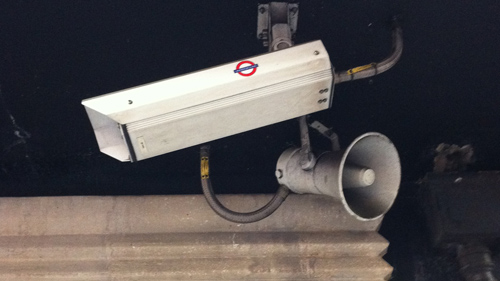
This is where the (slightly arcane) title of the exercise starts making sense. The walkshop is, for most participants, a first chance to look at their city as many layers of infrastructure, systems and information—sometimes interconnected, often crammed together without any interaction with one another.
See the antenna on the traffic light, allowing the express bus to encounter mostly green lights? Picture the network of microwave communications shuttling between the dish-spotted tall buildings at key intersections?
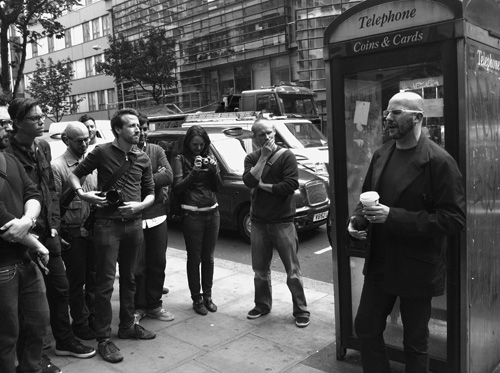
Beyond the slightly nerdy nature of the monicker, I sensed that Adam and co. had a much greater ambition than helping us look at the city through the lens of systems and layers. Proof came as soon as our second stop down the same street, a mere few paces away, around a phone booth.
No-one in our group checked that the telephone in the booth was even functional. No-one even entered the booth, as the stench and marks on the floor indicated that the booth had certainly been reconditioned as makeshift toilet – in itself an interesting case of urban adaptation, and probably the symptom of a need for better public toilets in our metropolises.
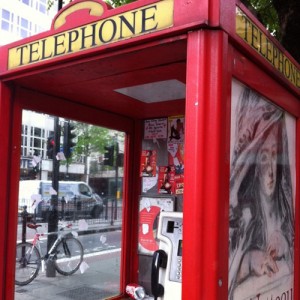
Somehow, the official function of the booth is a bit of an excuse: still useful for the less fortunate, the newcomers and the fringe individuals who can’t or won’t own a mobile phone “like everyone else”, the relevance of the phone booth now lies in the fact that it is a plot of land (owned by BT, and thus private property, one of the participants ventured) and a large, accepted piece of urban furniture. And as any marketer will tell you, urban furniture is not really meant to be used, it is mostly meant to be passed by, looked at and make money – both officially, as with the large ads plastered around the booth, and less so, with all the very suggestive ads, personals and other facilitators of trade and services patchworked inside.
Speaking of ads, we were fascinated to notice that the rotating ads at bus stops appeared to be managed through QR code stickers discretely applied at the top of the shelter. Indeed, if one looks hard enough, it is relatively easy to find barcodes, markings, and other various signs used as asset management for every box, chair, pole and panel in the city.
As a web geek, my eyes glitter when I see that every thing in the public space has a (hopefully) unique identifier. Not so much, of course, when I realise that there is no easy, clear way to use these identifiers (point at them, use them to talk about the objects, learn more about them…), but that’s is a start.
Another gem I carried back home was the idea of the Urban Markup Language – an invented name for all the markings and signs left on walls or pavement everywhere, imbued with obscure meaning and the codes of a profession: here a rivet surrounded by a thick chalk marking, there a couple of metal plates indicating the presence of fire hydrants, their size and capacity, and everywhere, the human hand and vagueness and imprecision tweaking and annotating the square, hard facts of the built environment.
All this in the course of a 90-minutes stroll around the block.
But the walkshop did not end there.
As we were eating and resting after all this, we all felt overwhelmed—like visitors in a foreign land, when early learnings suddenly transform the noise of surrounding conversations into a cacophony of signal—we were realising how much of the city was there to be seen if we only looked, understood if we only cared, and acted upon if we only dared.
Behind the disturbing strain of taking it all in, a devilish scheme was at play to make us regain consciousness, and perhaps even agency. We cannot be mere passer-bys anymore.
See also:
Previous/Next
Sometimes you hit the bar…
2011-04-24
He's hunched on the counter, coddling his drink, taking short sips between jokes, pouring his heart out. On the other side, the owner nods between orders and on occasion whips out a witty reply to his guest.
Alexander's itch
2011-07-03

